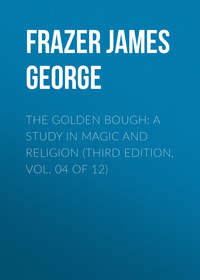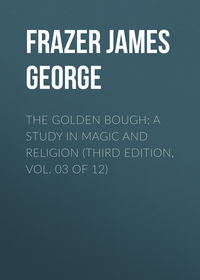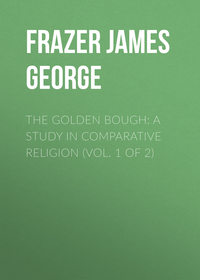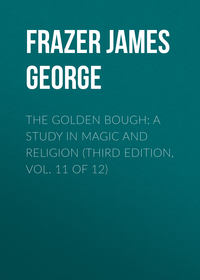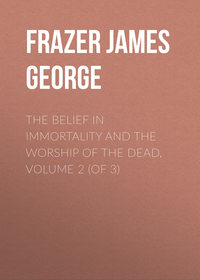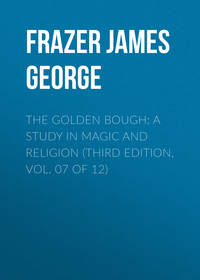 полная версия
полная версияThe Golden Bough: A Study in Magic and Religion (Third Edition, Vol. 09 of 12)
713
The opinion that at Rome a man used to be sacrificed at the Saturnalia cannot be regarded as in itself improbable, when we remember that down apparently to the establishment of Christianity a human victim was slaughtered every year at Rome in honour of Latian Jupiter. See Tertullian, Apologeticus, 9, Contra Gnosticos Scorpiace, 7; Minucius Felix, Octavius, 22 and 30; Lactantius, Divin. Instit. i. 21; Porphyry, De abstinentia, ii. 56. We may conjecture that at first the sacrifice took place on the top of the Alban Mountain, and was offered to Saturn, to whom, as we have seen, high places were sacred.
714
The Dying God, pp. 220 sqq.
715
Joannes Boemus, Mores, Leges, et Ritus Omnium Gentium (Lyons, 1541), p. 122; The Popish Kingdome or reigne of Antichrist, written in Latin verse by Thomas Naogeorgus and Englyshed by Barnabe Googe, 1570, edited by R. C. Hope (London, 1880), pp. 45 sq.; E. Pasquier, Recherches de la France (Paris, 1633), pp. 375 sq.; R. Herrick, “Twelfth Night, or King and Queene,” The Works of Robert Herrick (Edinburgh, 1823), ii. 171 sq.; J. Brand, Popular Antiquities of Great Britain (London, 1883), i. 21 sqq.; T. F. Thiselton Dyer, British Popular Customs (London, 1876), pp. 24-28; R. Chambers, The Book of Days (London and Edinburgh, 1886), i. 61 sqq.; Desgranges, “Usages du Canton de Bonneval,” Mémoires de la Société Royale des Antiquaires de France, i. (Paris, 1817) pp. 233-236; L. Beaulieu, Archéologie de la Lorraine (Paris, 1840-1843), i. 255 sq.; Reinsberg-Düringsfeld, Calendrier Belge (Brussels, 1861-1862), i. 23 sqq.; id., Das festliche Jahr (Leipsic, 1863), pp. 20-23; E. Cortet, Essai sur les Fêtes religieuses (Paris, 1867), pp. 29-50; J. H. Schmitz, Sitten und Sagen, Lieder, Sprüchwörter und Räthsel des Eifler Volkes (Trèves, 1856-1858), i. 6; Laisnel de la Salle, Croyances et Légendes du Centre de la France (Paris, 1875), i. 19-29; J. Lecœur, Esquisses du Bocage Normand (Condé-sur-Noireau, 1883-1887), ii. 125; L. Bonnemère, “Le Jour des Rois en Normandie,” Revue des Traditions populaires, ii. (1887) pp. 55 sq.; P. Sébillot, “La Fête des Rois,” Revue des Traditions populaires, iii. (1888) pp. 7-12; A. Meyrac, Traditions, Coutumes, Légendes et Contes des Ardennes (Charleville, 1890), pp. 74 sq.; J. L. M. Noguès, Les Mœurs d'autrefois en Saintonge et en Aunis (Saintes, 1891), pp. 49 sqq.; L. F. Sauvé, Le Folk-lore des Hautes-Vosges (Paris, 1889), pp. 16 sq.; Ch. Beauquier, Les Mois en Franche-Comté (Paris, 1900), pp. 16 sq.; F. Chapiseau, Le Folk-lore de la Beauce et du Perche (Paris, 1902), i. 312-315; Anatole France, “Le roy boit,” Annales Politiques et Littéraires, 5 Janvier, 1902, pp. 4 sq.; La Bresse Louhannaise, Janvier, 1906, pp. 42-46. The custom of making white crosses on the ceiling is reported for Germany and Switzerland, but apparently not for France. It is mentioned in the earliest of the works cited above, namely that of Joannes Boemus, whose description applies especially to Franconia (Franken).
716
This I learn from my friend M. Léon Chouville of Rouen and Cambridge. The custom is also kept up in Bresse (La Bresse Louhannaise, Janvier, 1906, pp. 44-46).
717
L. Beaulieu, Archéologie de la Lorraine (Paris, 1840-1843), i. 256 note 1; E. Cortet, Essai stir les Fêtes religieuses (Paris, 1867), p. 43.
718
L. F. Sauvé, op. cit. pp. 17 sq.
719
Anatole France, “Le roy boit,” Annales Politiques et Littéraires, 5 Janvier, 1902, p. 5. In some parts of France divination was practised for this purpose on Christmas Day. Twelve grains of wheat, each representing a month of the year, were placed, one after the other, on a hot fire-shovel; if the grain bounced up from the shovel, wheat would be dear in the corresponding month, but it would be cheap if the grain remained still. See J. B. Thiers, Traité des Superstitions (Paris, 1679), p. 268. See further P. Sébillot, Le Folk-lore de France, iii. (Paris, 1906) pp. 510 sq.
720
Ch. Beauquier, Les Mois en Franche-Comté (Paris, 1900), p. 12.
721
J. Lecœur, Esquisses du Bocage Normand (Condé-sur-Noireau, 1883-1887), ii. 126-129. Compare Amélie Bosquet, La Normandie Romanesque et Merveilleuse (Paris and Rouen, 1845), pp. 295 sq.; W. Mannhardt, Der Baumkultus (Berlin, 1875), pp. 536 sqq.
722
A. Meyrac, Traditions, Coutumes, Légendes et Contes des Ardennes (Charleville, 1890), pp. 75 sq.
723
J. Brand, Popular Antiquities of Great Britain, New Edition (London, 1883), i. 33. In many parishes of Gloucestershire it used to be customary on Twelfth Day to light twelve small fires and one large one (J. Brand, op. cit. i. 28).
724
The Gentleman's Magazine, vol. lxi., February, 1791, p. 116. The article is signed J. W. and dated “Hereford, Jan. 24.” The passage is quoted, correctly in substance, but with many verbal changes, by J. Brand, Popular Antiquities of Great Britain, i. 30 sq., and by (Mrs.) E. M. Leather, The Folk-lore of Herefordshire (Hereford and London, 1912), p. 93.
725
(Mrs.) Ella Mary Leather, The Folk-lore of Herefordshire (Hereford and London, 1912), pp. 93 sq.
726
(Mrs.) E. M. Leather, op. cit. pp. 94 sq.
727
See above, pp. 164 sqq.
728
G. F. Abbott. Macedonian Folk-lore (Cambridge, 1903), pp. 73-75.
729
This opinion is mentioned by (Mrs.) E. M. Leather, The Folk-lore of Herefordshire, p. 95.
730
Thomas Pennant, “A Tour in Scotland, 1769,” in John Pinkerton's Voyages and Travels (London, 1808-1814), iii. 49.
731
Thomas Hyde, Historia religionis veterum Persarum (Oxford, 1700), p. 257.
732
Sir Henry Piers, Description of the County of Westmeath, quoted by J. Brand, Popular Antiquities of Great Britain (London, 1883), i. 25.
733
H. J. Byrne, “All Hallows Eve and other Festivals in Connaught,” Folk-lore, xviii. (1907) p. 439.
734
C. S. Burne and G. F. Jackson, Shropshire Folk-lore (London, 1883), p. 408.
735
The Popish Kingdome or reigne of Antichrist, written in Latin verse by Thomas Naogeorgus and Englyshed by Barnabe Googe, 1570, edited by R. C. Hope (London, 1880), p. 46; E. Meier, Deutsche Sagen, Sitten und Gebräuche aus Schwaben (Stuttgart, 1852), p. 473, § 237; A. Birlinger, Volksthümliches aus Schwaben (Freiburg im Breisgau, 1861-1862), i. 468, § 696; A. Kuhn und W. Schwartz, Norddeutsche Sagen, Märchen und Gebräuche (Leipsic, 1848), p. 411; A. Kuhn, Sagen, Gebräuche und Märchen aus Westfalen (Leipsic, 1859), ii. 115, § 354; A. Wuttke, Der deutsche Volksaberglaube2 (Berlin, 1869), p. 61, § 74; Montanus, Die deutschen Volksfeste, Volksbräuche und deutscher Volksglaube (Iserlohn, n. d.), p. 18; M. Toeppen, Aberglauben aus Masuren2 (Danzig, 1867), p. 61; L. Strackerjan, Aberglaube und Sagen aus dem Herzogthum Oldenburg (Oldenburg, 1867), ii. 29, § 294; August Witzschel, Sagen, Sitten und Gebräuche aus Thüringen (Vienna, 1878), p. 175; K. Bartsch, Sagen, Märchen und Gebräuche aus Mecklenburg (Vienna, 1880), p. 250, § 1292; Christian Schneller, Märchen und Sagen aus Wälschtirol (Innsbruck, 1867), p. 231; J. Haltrich, Zur Volkskunde der Siebenbürger Sachsen (Vienna, 1885), p. 282; Willibald Müller, Beiträge zur Volkskunde der Deutschen in Mähren (Vienna and Olmutz, 1893), p. 317; Alois John, Sitte, Brauch und Volksglaube im deutschen Westböhmen (Prague, 1905), p. 12; P. Drechsler, Sitte, Brauch und Volksglaube in Schlesien (Leipsic, 1903-1906), i. 16 sq.
736
E. Meier, Deutsche Sagen, Sitten und Gebräuche aus Schwaben (Stuttgart, 1852), p. 473, § 237; A. Birlinger, Volksthümliches aus Schwaben (Freiburg im Breisgau, 1861-1862), i. 468, § 696.
737
A. Birlinger, op. cit. i. 470.
738
F. J. Vonbun, Beiträge zur deutschen Mythologie (Chur, 1862), p. 131; A. Birlinger, Volksthümliches aus Schwaben, i. 469; Chr. Schneller, Märchen und Sagen aus Wälschtirol (Innsbruck, 1867), p. 231.
739
Jules Lecoeur, Esquisses du Bocage Normand (Condé-sur-Noireau, 1883-1887), ii. 20 sq.
740
J. Loth, “Les douze jours supplémentaires (gourdeziou) des Bretons et les douze jours des Germains et des Indous,” Revue Celtique, xxiv. (1903) pp. 310 sq.
741
J. G. Campbell, Witchcraft and Second Sight in the Highlands and Islands of Scotland (Glasgow, 1902), p. 243.
742
Thomas Pennant, “A Tour in Scotland and Voyage to the Hebrides in 1772,” in John Pinkerton's Voyages and Travels (London, 1808-1814), iii. 384.
743
The Hymns of the Rigveda, translated by R. T. H. Griffith (Benares, 1889-1892), book iv. hymn 33, vol. ii. pp. 150 sqq.; H. Zimmer, Altindisches Leben (Berlin, 1879), pp. 365-367; A. Hillebrandt, Ritual-Litteratur, Vedische Opfer und Zauber (Strasburg, 1897), pp. 5 sq. However, the Ribhus are very obscure figures in Vedic mythology. Compare H. Oldenberg, Die Religion des Veda (Berlin, 1894), pp. 235 sq.; A. A. Macdonnell, Vedic Mythology (Strasburg, 1897), pp. 131 sqq.
744
F. Max Müller, Lectures on the Science of Language, Sixth Edition (London, 1871), i. 6 sqq.; O. Schrader, Reallexikon der indogermanischen Altertumskunde (Strasburg, 1901), p. 547; id., Sprachvergleichung und Urgeschichte3 (Jena, 1906-1907), ii. 228.
745
This explanation of the sacredness of the twelve days among the Indo-European peoples of the East and West is due to A. Weber. See O. Schrader, Reallexikon der indogermanischen Altertumskunde (Strasburg, 1901), pp. 391-394; id., Sprachvergleichung und Urgeschichte3 (Jena, 1906-1907), ii. 2. pp. 228-234. It is accepted by J. Loth (in Revue Celtique, xxiv. 1903, pp. 311 sq.), Professor H. Hirt (Die Indogermanen, Strasburg, 1905-1907, ii. 537, 544), Professor J. H. Moulton (Two Lectures on the Science of Language, Cambridge, 1903, pp. 47 sq.), and J. A. MacCulloch (in Dr. J. Hastings's Encyclopaedia of Religion and Ethics, iii. 81 sq.), but is rejected on what seem to me insufficient grounds by Professor O. Schrader (ll.cc.).
746
Spirits of the Corn and of the Wild, i. 307 sqq.
747
Die gestriegelte Rockenphilosophie (Chemnitz, 1759), pp. 860, 861; Bavaria, Landes- und Volkskunde des Königreichs Bayern (Munich, 1860-1867), i. 365; A. Wuttke, Der deutsche Volksaberglaube2 (Berlin, 1869), p. 61; P. Drechsler, Sitte, Brauch und Volksglaube in Schlesien (Leipsic, 1903-1906), i. 15; A. John, Sitte, Brauch und Volksglaube im deutschen Westböhmen (Prague, 1905), p. 11. The phrase “the Twelve Nights” in the sense of “the Twelve Days and Nights” is doubtless derived from the ancient Aryan custom of counting by nights instead of by days and of regarding the period of the earth's revolution on its axis as beginning with the night rather than with the day. See Caesar, De bello Gallico, vi. 18; Tacitus, Germania, 11; O. Schrader, Reallexikon der indogermanischen Altertumskunde (Strasburg, 1901), pp. 844 sqq.; J. Loth, “L'Année celtique,” Revue Celtique, xxv. (1904) pp. 115 sqq. The Athenians reckoned a day from sunset to sunset, and the Romans reckoned it from midnight to midnight (Censorinus, De die natali, xxiii. 3).
748
A. Tille, Die Geschichte der deutschen Weihnacht (Leipsic, preface dated 1893), pp. 3 sq., 281 sqq.; O. Schrader, Reallexikon der indogermanischen Altertumskunde (Strasburg, 1901), p. 392.
749
P. Drechsler, Sitte, Brauch und Volksglaube in Schlesien (Leipsic, 1903-1906), i. 15.
750
A. Wuttke, Der deutsche Volksaberglaube2 (Berlin, 1869), p. 61, § 74. As to the varying dates of the Twelve Nights see further E. Mogk, “Mythologie,” in H. Paul's Grundriss der germanischen Philologie, iii.2 (Strasburg, 1900), p. 260.
751
See above, p. 324.
752
Thus A. Wuttke observes that by far the greater part of the superstitions attaching to the Twelve Nights are of purely heathen origin (Der deutsche Volksaberglaube,2 p. 61); and K. Weinhold similarly remarks that the superstitions in question cannot have originated in Christian dogmas, and that they point to the sacredness of the winter solstice among the heathen tribes of Germany (Weinacht-Spiele und Lieder aus Süddeutschland und Schlesien, Vienna, 1875, p. 4).
753
See Adonis, Attis, Osiris, Second Edition, pp. 254 sqq.; and for Easter in particular see my letter “Attis and Christ,” The Athenaeum, No. 4184, January 4th, 1908, pp. 19 sq.; Franz Cumont, Les Religions orientales dans le Paganisme romain2 (Paris, 1909), pp. 106 sq., 333 sq.
754
J. Brand, Popular Antiquities of Great Britain (London, 1883), i. 21 sq.; E. Cortet, Essai sur les Fêtes religieuses (Paris, 1867), pp. 32, 38, 39-42; Reinsberg-Düringsfeld, Calendrier Belge (Brussels, 1861-1862), i. 21 sq., 30 sq.; id., Fest-Kalender aus Böhmen (Prague, n. d.), p. 18; id., Das festliche Jahr (Leipsic, 1863), pp. 23-26; Bavaria, Landes- und Volkskunde des Königreichs Bayern (Munich, 1860-1867), ii. 262 sq.; L. F. Sauvé, Le Folk-lore des Hautes-Vosges (Paris, 1889), pp. 15-18; Ch. Beauquier, Les Mois en Franche-Comté (Paris, 1900), pp. 13-15; La Bresse Louhannaise, Janvier, 1906, p. 42; P. Drechsler, Sitte, Brauch und Volksglaube in Schlesien (Leipsic, 1903-1906), i. 51; A. John, Sitte, Brauch und Volksglaube im deutschen Westböhmen (Prague, 1905), pp. 32-34; E. Hoffmann-Krayer, Feste und Bräuche des Schweizervolkes (Zürich, 1913), pp. 104, 121.
755
Matthew ii. 1-12.
756
Ch. Beauquier, Les Mois en Franche-Comté (Paris, 1900), pp. 13-16.
757
L. F. Sauvé, Le Folk-lore des Hautes-Vosges (Paris, 1889), pp. 15-17. Compare the old Roman cure for the falling sickness (above, p. 68).
758
O. Freiherr von Reinsberg-Düringsfeld, Fest-Kalender aus Böhmen (Prague, n. d.), pp. 17 sq.
759
Reinsberg-Düringsfeld, Calendrier Belge (Brussels, 1861-1862), i. 22. The mere names of the three kings worn on the person were believed to be a cure for epilepsy. See J. B. Thiers, Traité des Superstitions (Paris, 1679), pp. 350 sq.
760
R. Chambers, The Book of Days (London and Edinburgh, 1886), i. 62, referring to Warton's History of English Poetry.
761
J. Brand, Popular Antiquities of Great Britain (London, 1883), i. 497 sqq.; E. K. Chambers, The Mediaeval Stage (Oxford, 1903), i. 403 sqq.
762
John Stow, A Survey of London, written in the year 1598, edited by William J. Thoms (London, 1876), p. 37.
763
Sir Thomas Urquhart, The Discovery of a most Exquisite Jewel, more precious than Diamonds inchased in Gold (Edinburgh, 1774), p. 146.
764
J. Brand, op. cit. i. 499.
765
J. Brand, Popular Antiquities of Great Britain (London, 1883), i. 497 sqq. As to the Lords of Misrule in colleges and the Inns of Court see further E. K. Chambers, The Mediaeval Stage, i. 407 sqq.
766
Sir Richard Steele, in The Spectator, Friday, 14th December 1711.
767
E. K. Chambers, The Mediaeval Stage, i. 405-407.
768
L. J. B. Bérenger-Feraud, Superstitions et Survivances, iv. (Paris, 1896) pp. 4 sq., quoting Jacob, Mœurs et Coutumes du Moyen-Age. Compare E. Cortet, Essai sur les Fêtes religieuses (Paris, 1867), pp. 50 sqq. In some places the festival was held on the octave of Epiphany. See E. K. Chambers, The Mediaeval Stage (Oxford, 1903), i. 323.
769
E. Cortet, op. cit. p. 51; Papon, Histoire Générale de la Provence, iii. p. 212, quoted by L. J. B. Bérenger-Feraud, op. cit. iv. 9 sq.; E. K. Chambers, The Mediaeval Stage (Oxford, 1903), i. 293 sq., quoting a circular letter which was addressed by the Faculty of Theology at Paris to the bishops and chapters of France on March 12th, 1445. Many details as to the mode of celebrating the Festival of Fools in different parts of France are on record. See A. de Nore, Coutumes, Mythes, et Traditions des Provinces de France (Paris and Lyons, 1846), pp. 293-295; E. Cortet, op. cit. pp. 52 sqq.; L. J. B. Bérenger-Feraud, op. cit. iv. 5 sqq.; G. Bilfinger, Untersuchungen über die Zeitrechnung der alten Germanen, ii. Das germanische Julfest (Stuttgart, 1901), pp. 72 sq.; and especially E. K. Chambers, The Mediaeval Stage, i. 274 sqq.
770
E. Cortet, Essai sur les Fêtes religieuses (Paris, 1867), pp. 53-56; L. J. B. Bérenger-Feraud, Superstitions et Survivances, iv. 28-41; E. K. Chambers, The Mediaeval Stage (Oxford, 1903), i. 330-334. While the Festival of Fools appears to have been most popular in France, it is known to have been celebrated also in Germany, Bohemia, and England. See E. K. Chambers, op. cit. i. 318 sqq. In his youth the Bohemian reformer John Huss took part in these mummeries. The revellers wore masks. “A clerk, grotesquely vested, was dubbed ‘bishop,’ set on an ass with his face to the tail, and led to mass in the church. He was regaled on a platter of broth and a bowl of beer, and Huss recalls the unseemly revel which took place. Torches were borne instead of candles, and the clergy turned their garments inside out and danced” (E. K. Chambers, op. cit. i. 320 sq.).
771
E. Cortet, Essai sur les Fêtes religieuses, p. 58; E. K. Chambers, The Mediaeval Stage (Oxford, 1903), i. 317 sq., 336 sqq. Compare L. J. B. Bérenger-Feraud, Superstitions et Survivances, iv. 25-28. From the evidence collected by the latter writer it appears that in some places the election of the Boy Bishop took place on other days than Childermas. At Alençon the election took place on the sixth of December; at Vienne, in Dauphiné, on the fifteenth, and at Soissons on St. Thomas's Day (the twenty-first of December).
772
This I learn from my wife, who as a girl was educated in the convent.
773
J. Brand, Popular Antiquities of Great Britain (London, 1883), i. 421-431; E. K. Chambers, The Mediaeval Stage (Oxford, 1903), i. 352 sqq.; (Mrs.) Ella Mary Leather, The Folk-lore of Herefordshire (Hereford and London, 1912), pp. 138 sq.; County Folk-lore, II. North Riding of Yorkshire, York and the Ainsty, edited by Mrs. Gutch (London, 1901), pp. 352 sq.
774
J. Brand, op. cit. i. 426.
775
As to the Aztec year see above, p. 287 note 1.
776
B. de Sahagun, Histoire Générale des Choses de la Nouvelle Espagne, traduite par D. Jourdanet et R. Simeon (Paris, 1880), pp. 77, 283; E. Seler, “The Mexican Chronology,” in Bureau of American Ethnology, Bulletin No. 28 (Washington, 1904), p. 16 (where some extracts from the Aztec text of Sahagun are quoted and translated); J. de Acosta, Natural and Moral History of the Indies (Hakluyt Society, London, 1880), ii. 392.
777
Diego de Landa, Relation des Choses de Yucatan (Paris, 1864), pp. 204 sq., 276 sq.
778
Geminus, Elementa Astronomiae, viii. 18, p. 106, ed. C. Manitius (Leipsic, 1898).
779
G. Foucart, in Dr. J. Hastings's Encyclopaedia of Religion and Ethics, iii. (1910) p. 93. Professor Ed. Meyer adduces astronomical and other grounds for thinking that the ancient Egyptian calendar, as we know it, began on the 19th of July, 4241 b. c., which accordingly he calls “the oldest sure date in the history of the world.” See Ed. Meyer, Geschichte des Altertums2, i. 2. (Stuttgart and Berlin, 1909), pp. 101 sq., § 197; and against this view C. F. Lehmann-Haupt, in the English Historical Review, April 1913, p. 348.
780
Plutarch, Isis et Osiris, 12. Compare Diodorus Siculus, i. 13. 4 sq. As to Keb and Nut, the parents of Osiris, Isis, and the rest, see A. Erman, Die ägyptische Religion (Berlin, 1905), p. 29. The Egyptian deities Keb, Nut, and Thoth are called by Plutarch by the Greek names of Cronus, Rhea, and Hermes. On account of these Greek names the myth was long thought to be of comparatively recent date; “but the Leyden Papyrus (i. 346) has shown that the legend existed in its essential features in the time of the Thebans, and the Texts of the Pyramids have carried it back to the very beginnings of Egyptian mythology” (G. Foucart, l. c.). As five days are the seventy-second, not the seventieth, part of three hundred and sixty days, it was proposed by Wyttenbach to read τὸ ἑβδομηκοστὸν δεύτερον instead of τὸ ἑβδομηκοστὸν in Plutarch's text. See D. Wyttenbachius, Animadversiones in Plutarchi Moralia (Leipsic, 1820-1834), iii. 143 sq.
781
H. Zimmer, Altindisches Leben (Berlin, 1879), pp. 365-370. Compare The Hymns of the Rigveda, translated by R. T. H. Griffith (Benares, 1889-1892), Book i. Hymn 164, stanza 48 (vol. i. p. 293), Book iii. Hymn 55, stanza 18 (vol. ii. pp. 76 sq.).
782




